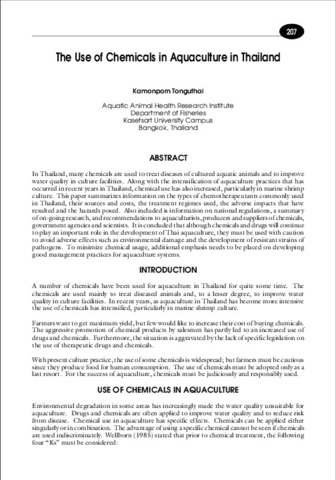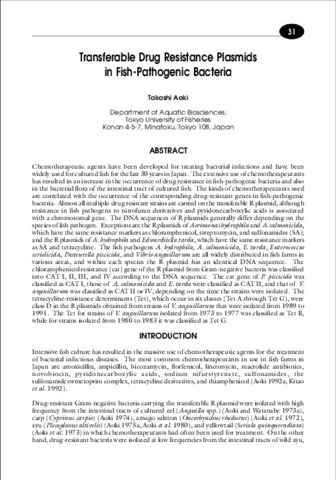The use of chemicals in aquaculture in Thailand
- Global styles
- MLA
- Vancouver
- Elsevier - Harvard
- APA
- Help

Date
2000Author
Page views
10,638ASFA keyword
aquaculturists 
drug resistance
chlorine
antibiotics
zeolites
aquaculture
hormones
feed composition
fertilizers
disinfectants
insecticides
aquatic drugs
vitamins
iodine
drugs
fish culture
policies
shrimp culture
husbandry diseases
environmental impact
saponins
aquaculture systems
control methods
hatcheries
intensive aquaculture
aquaculture development
dyes
dolomite
mariculture
vaccines

drug resistance

chlorine

antibiotics

zeolites

aquaculture

hormones

feed composition

fertilizers

disinfectants

insecticides

aquatic drugs

vitamins

iodine

drugs

fish culture

policies

shrimp culture

husbandry diseases

environmental impact

saponins

aquaculture systems

control methods

hatcheries

intensive aquaculture

aquaculture development

dyes

dolomite

mariculture

vaccines

Metadata
Show full item record
Share
Abstract
In Thailand, many chemicals are used to treat diseases of cultured aquatic animals and to improve water quality in culture facilities. Along with the intensification of aquaculture practices that has occurred in recent years in Thailand, chemical use has also increased, particularly in marine shrimp culture. This paper summarizes information on the types of chemotherapeutants commonly used in Thailand, their sources and costs, the treatment regimes used, the adverse impacts that have resulted and the hazards posed. Also included is information on national regulations, a summary of on-going research, and recommendations to aquaculturists, producers and suppliers of chemicals, government agencies and scientists. It is concluded that although chemicals and drugs will continue to play an important role in the development of Thai aquaculture, they must be used with caution to avoid adverse effects such as environmental damage and the development of resistant strains of pathogens. To minimize chemical usage, additional emphasis needs to be placed on developing good management practices for aquaculture systems.
Suggested Citation
Tonguthai, K. (2000). The use of chemicals in aquaculture in Thailand. In J. R. Arthur, C. R. Lavilla-Pitogo, & R. P. Subasinghe (Eds.), Use of Chemicals in Aquaculture in Asia: Proceedings of the Meeting on the Use of Chemicals in Aquaculture in Asia, 20-22 May 1996, Tigbauan, Iloilo, Philippines (pp. 207-220). Tigbauan, Iloilo, Philippines: Aquaculture Department, Southeast Asian Fisheries Development Center.
Type
Conference paperISBN
9718511490Collections
Related items
Showing items related by title, author, creator and subject.
-
Use of Chemicals in Aquaculture in Asia: Proceedings of the Meeting on the Use of Chemicals in Aquaculture in Asia, 20-22 May 1996, Tigbauan, Iloilo, Philippines
Arthur, J. Richard; Lavilla-Pitogo, Celia R.; Subasinghe, Rohana P. (Aquaculture Department, Southeast Asian Fisheries Development Center, 2000)The use of chemicals is common in various aquaculture systems, as it is in many agricultural practices. However, with growing worldwide awareness of the need for responsible practices in aquaculture, governments and ... -
Changes induced in the gills of milkfish (Chanos chanos Forsskål) fingerlings after acute exposure to nifurpirinol (Furanace; P-7138)
Tamse, Catherine T.; Gacutan, Rogelio Q.; Tamse, Armando F. (Springer Verlag, 1995)The need for a chemotherapeutant used specifically for fish disease became increasingly apparent with intensive fish culture practices, and with the possibility of bacterial resistance against drugs used for human and ... -
Transferable drug resistance plasmids in fish-pathogenic bacteria
Aoki, Takashi (Aquaculture Department, Southeast Asian Fisheries Development Center, 2000)Chemotherapeutic agents have been developed for treating bacterial infections and have been widely used for cultured fish for the last 30 years in Japan. The extensive use of chemotherapeutants has resulted in an increase ...




